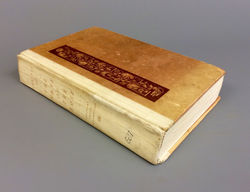![[Before Treatment]](https://static.wixstatic.com/media/1de16c_b4c90f5234474e61ae54fc48dd7958f8~mv2_d_2499_1687_s_2.jpg/v1/fill/w_250,h_168,al_c,q_90,enc_auto/1de16c_b4c90f5234474e61ae54fc48dd7958f8~mv2_d_2499_1687_s_2.jpg) [Before Treatment] |  [After Treatment |
|---|---|
![[Before Treatment]](https://static.wixstatic.com/media/1de16c_4a3b454804ce4ebaa4656d612d23f949~mv2_d_3264_2448_s_4_2.jpg/v1/fill/w_250,h_187,al_c,q_90,enc_auto/1de16c_4a3b454804ce4ebaa4656d612d23f949~mv2_d_3264_2448_s_4_2.jpg) [Before Treatment] |  [After Treatment |
![[Before Treatment]](https://static.wixstatic.com/media/1de16c_01b2fc7961e345db9be7411e72d74cf7~mv2_d_2746_1728_s_2.jpg/v1/fill/w_250,h_157,al_c,q_90,enc_auto/1de16c_01b2fc7961e345db9be7411e72d74cf7~mv2_d_2746_1728_s_2.jpg) [Before Treatment] |  [After |
The Name of the Rose, 1980
by Umberto Eco
Treatment performed at: The Charleston Library Society Book Conservation Studio
Overseen by Conservator: Brien Beidler
Late-twentieth-century circulating book with a tear in the cloth spine, repaired with Japanese tissue to strengthen the hollow spine
This more modern volume was in a state of poor condition equivalent to that of much older volumes because of rapidly deteriorating cardboard, linen, and mesh. Mr. Beidler says it is a major issue of our times that modern books deteriorate much more quickly than historic volumes because of poor materials. The spine was previously torn and repaired using an irreversible glue, which I removed mechanically. Then I performed a modified hollow spine repair just like the previous two circulating books I repaired at the CHS, English Pleasure Gardens (1929) and The Danube (1939). I entered the volume's condition and treatment proposal into the circulation repair log, a condensed condition report used by Mr. Beidler in the Book Conservation Studio.
For the modified hollow spine repair, slightly altered from the previous implementation of the procedure, a piece of Japanese tissue was cut the height of the spine and 6X the width of the spine. This time about a third of the tissue was left dry above the repair while the tissue was applied with 1:1 methyl cellulose and wheat paste mixture over the text block and spine. This was allowed to dry with the mylar between the spine and text block and holitex tightly holding the book closed like a dust jacket. After drying, the spine was reopened, the text block rewetted and the mylar put back. The third of dry tissue was then folded over the mylar and spine and secured with glue. The spine was closed again with holitex to try overnight.